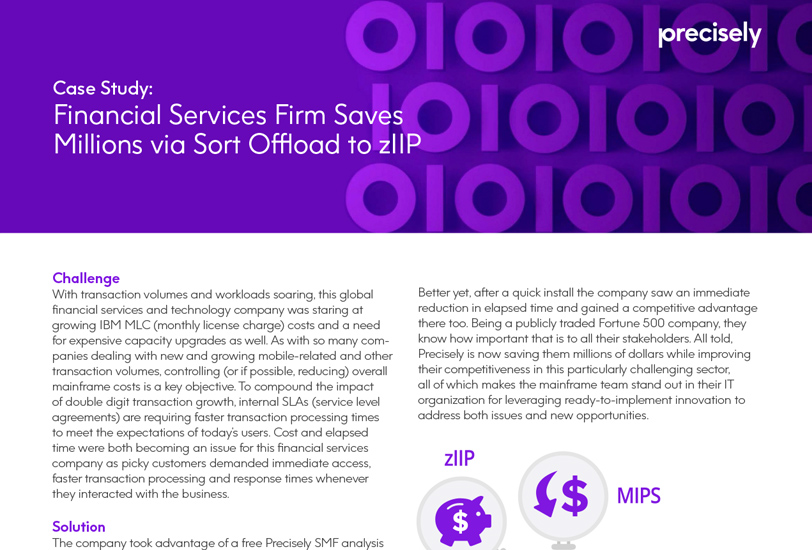
IBM MAINFRAME SOLUTIONS
IBM mainframe solutions
Get more value from your IBM Z investment with enhanced performance, improved efficiency, and better capacity and network management.
Optimizing your mainframe
Most Fortune 500 corporations (many believe over 90%) rely on the IBM Z, or its mainframe ecosystem, for their most business-critical IT workload. This computing platform provides exceptional security, reliability, and performance to support the growing workloads for these corporations. Enterprise initiatives into cloud or digital transformations are evolving their IBM Z strategies to support application modernization and hybrid cloud.
The challenge of keeping up with rising data volumes and to the core business applications and data on IBM Z creates continuous pressure to squeeze more performance out of the existing platform to avoid or defer major upgrades.
Companies faced with these modern mainframe challenges can start to move forward by improving the quality of some seemingly mundane processing tasks, like sort performance, storage optimization and improved database management to boost IBM Z benefits. Additional efficiency can be obtained from improved capacity and network management solutions.


Mainframe sort optimazation with zIIP offload
As the pressure grows for mainframe operators to improve performance while maintaining or decreasing costs, one area that is commonly the focus of optimization is mainframe sort performance. Sorting data is one of the most MIPS-intensive functions your mainframe performs. It consumes as much as 25% of your CPU cycles. Not only is sorting a frequently used function, it also operates behind the scenes of other processes, such as data compression. Reducing the resources used for sorting can significantly increase overall system efficiency.
Syncsort™ MFX is a high-performance sort, copy and join application, designed to take advantage of the latest IBM z Systems architecture to improve sort performance over IBM’s DFSORT solution.
Offloading workloads to IBM zIIP engines is another area of focus when optimizing mainframe workload. IBM introduced z Integrated Information Processors (zIIP) over a decade ago. zIIP is a purpose-built processor designed to operate asynchronously from general processors (CP) in the mainframe to provide additional computing capacity, without any associated software licensing charges.
Syncsort™ ZPSaver is a licensable feature of Syncsort™ MFX that allows over 90% of the sort workload to be offloaded to zIIP. This dramatically reduces MLC (IBM’s Monthly License Charge). Because MLC is directly tied to CPU usage, reducing MIPS consumption is vital for getting more out of your mainframe without increasing costs.
Enhancing Storage Management
Storage management on IBM Z isn’t just an administrative concern. It’s a foundational part of keeping enterprise systems fast, reliable, and secure. In mainframe environments, where massive volumes of data are processed daily and uptime is non-negotiable, managing storage effectively is critical to ensuring everything runs smoothly.
IBM Z handles some of the world’s most important workloads: financial transactions, healthcare records, government services, and more. These systems rely on high-speed access to data and strict control over how that data is stored, migrated, archived, and recovered. Poor storage management slows down batch processing, increases resource contention, and leads to avoidable outage. None of these are acceptable when SLAs and customer trust are on the line.
Good storage management on IBM Z helps you automate routine tasks like space allocation, recall of migrated datasets, and cleanup of unused resources. It ensures data is stored in the right place—on the right tier of storage—based on usage, business value, and regulatory needs. It also helps prevent failures like out-of-space errors, overuse of high-cost resources, or performance bottlenecks during critical processing windows.
Security and compliance are also major factors. Storage policies on IBM Z help control retention, protect sensitive information, and support regulatory audits. With cyber threats like ransomware on the rise, having the ability to quickly back up, isolate, and recover datasets is no longer optional—it’s essential.
In short, without effective storage management, you’re taking risks with performance, availability, cost, and compliance. With it, you gain control, improve efficiency, and ensure your IBM Z systems continue delivering the stability and speed your business depends on. Storage isn’t just infrastructure—it’s a strategic advantage


Migration from IMS to Db2
CIOs must continually assess their IT infrastructure to determine how to address new business demands as quickly as possible while also minimizing costs and risks. Many are concerned with how to approach their mainframe and legacy environments. One frequent target of these optimization efforts is IBM’s Information Management Systems (IMS).
IMS offers strong performance, support for high transaction volumes and high availability. It has been the workhorse mainframe database that many financial services firms, retailers, distributors, manufacturers and government agencies trust to keep core components of their operations running.
However, many modern applications require a relational database, such as Db2, for their operations. Additionally, the staff that have traditionally supported IMS are nearing retirement age, and new administrators typically have stronger Db2 skills.
There are significant challenges and risks for organizations looking to move from IMS to Db2. Completely rewriting IMS-based applications requires considerable effort and poses significant risks since some IMS-based applications run critical business processes and have been around for decades.
Syncsort™ Optimize IMS provides rapid and efficient migration between IMS and Db2, without the traditional risks and costs associated with rewriting applications to support Db2. Syncsort™ Optimize IMS works with your existing software so your applications can remain unchanged.
Planning, managing, and optimizing IT capacity
Effectively planning your IT infrastructure plays a critical role in your company’s ability to compete and grow. Poorly planned infrastructure and outages can seriously hinder that growth, while a robust IT infrastructure will enable it. You are responsible for every aspect of infrastructure management, including managing core business systems and planning for scaling up and out to handle increased business volumes, all while protecting and optimizing the capabilities you have today.
Perhaps the most challenging aspect of this is the need for scalability. It’s hard enough to get agreement on just what level of IT capability is “right-sized” for your business today. How do you adjust and revise that answer when your business is growing, changing, and morphing all the time? Do you wait until there is a big change in requirements to reassess? Or do you try to stay just ahead of the curve, maintaining some limited amount of excess capacity and capability to handle tomorrow’s needs? If the latter, how much is enough and how do you justify investments that are over-and-above immediate needs, when IT budgets are set in stone and resources are finite?
You need to replace ad-hoc queries, labor-intensive manual processes, and error-prone spreadsheets with a true capacity management solution that automates the continuous collection and storage of all available systems and application performance monitoring and alert data. This includes data from mainframe, physical, virtual, and cloud-hosted systems.
Syncsort™ Capacity Management delivers an automated, single view of your IT resources, no matter where they reside. All major on-premises and cloud platforms are covered.
Syncsort™ Capacity Management continuously monitors server, application and network resources to provide detailed, actionable visibility into all your IT metrics.


Integrating mainframe into security analytics and IT management platforms
Mainframe systems process massive volumes of critical and sensitive information every day. In the past, they operated in relative isolation, but today, most are key elements of an overall IT infrastructure connected to a network or the Internet, making them vulnerable to cybersecurity threats and incidents.
If you aren’t integrating your mainframe security and IT operations data with data from the other systems in your IT environment, you have only part of the picture you need to manage your IT world, and will not have the true visibility you need if you’re focusing on one technology silo at a time. The log data they generate is needed by your Security Information and Event Management System (SIEM) and by your IT Operations Analytics ITOA) platform.
Precisely Ironstream allows you to get siloed mainframe security and machine data off the mainframe and into today’s IT analytics platforms like ServiceNow and Splunk. This gives you a 360-degree view of your security environment and IT infrastructure that can power better security, IT operations and management decisions.
Network monitoring and management
IBM’s current mainframe technology provides large servers with a distinctive strength in handling both a high volume of transactions and input/output operations in parallel. The mainframe can serve many network nodes geographically dispersed across the world, while simultaneously handling a high volume of input and output operations to disk storage, printers, and other attached computers.
Network performance has become so important that sophisticated IP monitoring tools are essential for any modern mainframe organization, providing alerts to potential problems, helping your developers and network managers to diagnose problems, and providing historical performance reports. Staying on top of the network’s efficiency and security is vital to cutting costs and improving network management.
Syncsort™ Network Management increases your network security and efficiency with a package of specialized components, including network monitoring, security and performance management. Syncsort™ Network Management is customizable to meet your exact needs and you can use Syncsort™ Network Management to maintain your company’s service levels and support the continuity of your business.


Case study:
Telecommunication Firm saves big with Syncsort™ MFX
With CPU utilization peaking at 100% in the daily batch window when critical billing jobs were running, this telecommunications firm was seeing the performance of the jobs being impacted, along with an occasional inability to complete all jobs within the window. They were looking at an impending upgrade which they could neither afford nor manage.
Taking advantage of a free Precisely SMF analysis, they received a projection on how much they could save in terms of MIPS with Syncsort™ MFX. The results were astounding. They showed an average savings of 72.4% in CPU time, along with an 11% savings in elapsed time within their current batch window.
Case study:
Sort Swap Saves $ for This Mexican Bank
A careful analysis performed for this Mexico-based banking and financial services firm indicated that routine batch processing of sort functions in the mainframe environment was costing about $1 million annually – just in CPU time.
Equally concerning was how the CPU time for sort jobs was encroaching on the 11 a.m. to 5 p.m. period when CPU time was critically important for vital business applications like transaction processing, CRM, and others. At stake were customer satisfaction, service level agreements, and similar matters.

Keys to mainframe success
What do 96 of the world’s 100 largest banks, 90% of the largest insurance companies, 92% of the largest retailers in the United States, and 71% of the Fortune 500 have in common? They all depend on mainframes for their most business-critical workloads. People have been predicting the imminent demise of mainframes for years. But so far, they’ve been wrong. Although the roles played by mainframes have certainly changed somewhat over time, they remain essential in many major industries. It seems a safe bet, then, that mainframes will continue to thrive.
As quickly as the mobile economy and online transaction processing applications are growing, the innovations required to accommodate the ongoing challenges in the mainframe realm continue to keep pace. Whether you need to improve core capabilities like sorting operations or broader challenges like capacity and network management, finding new, innovative solutions to today’s challenges while planning for future needs will be the keys to success.



